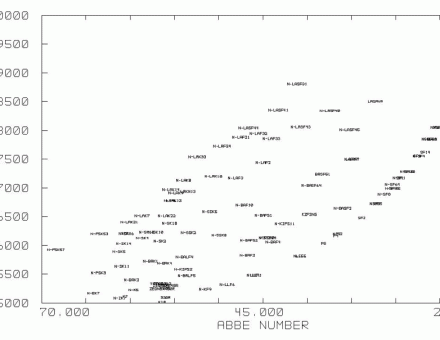Optical components are fabricated using a variety of materials including optical glasses, engineered plastics, and crystalline materials.
Glass material is the most common type because of its excellent optical properties such as high light transmission and environmental stability. There are many types of glass materials suitable for making optical components. The specific selection depends on the optical performance requirement, environmental suitability, ease of fabrication, and cost. The main characteristics of an
optical material are represented by its refractive index (Nd) and its dispersion.
Suitable plastic materials can also be used in fabricating low-precision optical components. There are only a handful of plastic materials with a limited index of refraction and Abbe values to choose from. The highest available index is about 1.6. The main benefit of plastic material is that it can be made by various molding techniques thus reducing the cost of manufacturing. However, the precision achievable with plastic is limited by the material properties and the molding process. Plastic optics are typically used as eyeglass lenses, magnifier lenses, educational optics, etc. Plastic optics can also be combined with glass optics to form hybrid optical systems.
Download a white paper on “plastic vs. glass optics”.
Special materials such as quartz, sapphire, fused silica, etc are also used to fabricate optical components. Optical quartz is a birefringent material with non-isotropic optical properties. It is used in optical low-pass filters and specialized fiber-optic devices. Sapphire is a special material with very durable surface quality. It is often used to fabricate optical windows which protects the internal optical components against harsh environment. Fused silica material has excellent UV transmission, and it is very stable thermally. It is used for fabricating UV optics such as lenses and prisms.
The following table shows a list of most commonly used materials along with their key properties. Definition of terms used in the following table is as follows:
- Nd: Refractive index at d-line wavelength (587nm).
- Abbe: (Nd-1)/(NF-NC), F-line is at 485nm and C-line is at 656nm
- TCE: Thermal coefficient of expansion in 10E-7/C.
- Density: Material density in g/cm3.
- Lmin: The material transmission band begins at this wavelength in µm.
- Lmax: The material transmission band stops at this wavelength in µm.
- MILcode: A six digit code developed by US military to represent glass name. The first three digits are the first three digits of the fraction of the Nd. The other three digits are the first three digits of the Abbe # without the decimal point.
| Name click for more info |
Description | Nd | Abbe | TCE | Density | Lmin | Lmax |
FusedSilica |
UV-IR optical material and low thermal expansion, expensive | 1.458464 | 67.821434 | 0.54 | 2.2 | 0.21 | 3.71 |
FK5 |
Low index, low dispersion general purpose optical glass | 1.48749 | 70.410004 | 10 | 2.45 | 0.334 | 2.5 |
BK7 |
General purpose optical glass, the most common type | 1.5168 | 64.169998 | 7.1 | 2.51 | 0.334 | 2.325 |
LLF6 |
Low-index optical flint glass | 1.53172 | 48.759998 | 8.5 | 2.81 | 0.334 | 2.325 |
BAK1 |
General purpose optical glass, higher index than BK7 | 1.5725 | 57.55 | 7.6 | 3.19 | 0.29 | 2.5 |
F2 |
General purpose optical flint glass | 1.62004 | 36.369999 | 8.2 | 3.61 | 0.334 | 2.5 |
SK16 |
General purpose optical glass, higher index than BK7 | 1.62041 | 60.32 | 7.3 | 3.58 | 0.334 | 2.5 |
SF2 |
High index optical flint glass | 1.64769 | 33.849998 | 8.4 | 3.86 | 0.334 | 2.325 |
BAFN10 |
General purpose optical glass | 1.67003 | 47.11 | 6.8 | 3.61 | 0.334 | 2.325 |
SF5 |
High index optical flint glass | 1.6727 | 32.209999 | 8.2 | 4.07 | 0.334 | 2.325 |
SF8 |
High index optical flint glass | 1.68893 | 31.18 | 8.2 | 4.22 | 0.334 | 2.5 |
SF1 |
High index optical flint glass | 1.71736 | 29.51 | 8.8 | 4.46 | 0.334 | 2.5 |
SF10 |
High index optical flint glass | 1.72825 | 28.41 | 7.5 | 4.28 | 0.334 | 2.325 |
LAF2 |
High index, lower dispersion glass, expensive | 1.744 | 44.720001 | 9 | 4.34 | 0.334 | 2.325 |
SF4 |
High index optical flint glass | 1.7552 | 27.58 | 8.9 | 4.79 | 0.334 | 2.5 |
Sapphire |
Durable material, excellent for optical windows | 1.768234 | 72.237213 | 6.65 | 3.987 | 0.2 | 5.5 |
ZNSE |
IR transmitting glass. Useful for IR optics | 2.62411 | 8.282769 | 7.8 | 5.264 | 0.55 | 18 |

